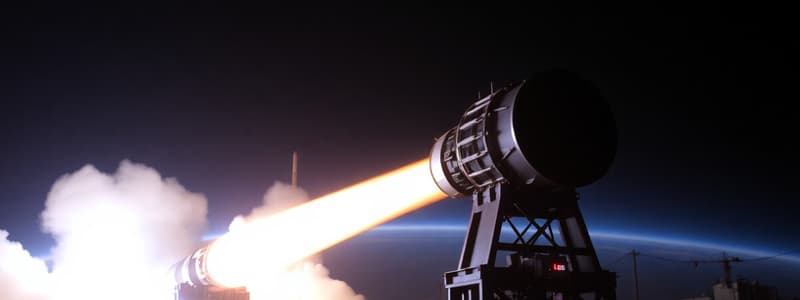Podcast
Questions and Answers
What was the peak altitude reached by Aftershock II?
What was the peak altitude reached by Aftershock II?
- 470,000 feet (correct)
- 450,000 feet
- 380,000 feet
- 143.3 miles
How long did it take Aftershock II to reach its maximum speed?
How long did it take Aftershock II to reach its maximum speed?
- 25 seconds
- 30 seconds
- 19 seconds (correct)
- 10 seconds
What significant achievement did RPL accomplish in 2019?
What significant achievement did RPL accomplish in 2019?
- Traveler IV crossed the Kármán line. (correct)
- They launched the first rocket to the moon.
- They set a new speed record with GoFast.
- They deployed a successful satellite.
Which material was used on the fins of Aftershock II to withstand high speeds?
Which material was used on the fins of Aftershock II to withstand high speeds?
What is the main objective of RPL's future rocket projects?
What is the main objective of RPL's future rocket projects?
How high above Earth's surface is the Kármán line located?
How high above Earth's surface is the Kármán line located?
What was the original altitude record set by the GoFast rocket in 2004?
What was the original altitude record set by the GoFast rocket in 2004?
What innovative feature did Aftershock II utilize for real-time tracking?
What innovative feature did Aftershock II utilize for real-time tracking?
Flashcards
Kármán Line
Kármán Line
The imaginary line located 100 kilometers (62 miles) above Earth's surface, marking the internationally recognized boundary between Earth's atmosphere and outer space.
Sounding Rocket
Sounding Rocket
A rocket designed to carry scientific instruments into space for short-duration research missions, often returning data through telemetry.
Aftershock II
Aftershock II
A rocket built by USC Rocket Propulsion Lab (RPL), reaching a record-breaking altitude of 470,000 feet (143.3 km).
Previous Amateur Rocket Altitude Record
Previous Amateur Rocket Altitude Record
Signup and view all the flashcards
Rocket Altitude
Rocket Altitude
Signup and view all the flashcards
Mach Speed
Mach Speed
Signup and view all the flashcards
Breaking the Sound Barrier
Breaking the Sound Barrier
Signup and view all the flashcards
Engine Burnout
Engine Burnout
Signup and view all the flashcards
Study Notes
USC Rocket Propulsion Lab's Aftershock II Achievement
- Aftershock II, a student-built rocket, surpassed the 20-year-old amateur rocket altitude record.
- Launched from the Black Rock Desert in Nevada on October 20, 2024.
- Reached an altitude of 470,000 feet (143.3 km), exceeding the previous record of 380,000 feet (115.8 km) set by GoFast in 2004 by 90,000 feet (27.4 km).
- Broke the sound barrier within two seconds of launch.
- Achieved a maximum speed of 3,600 mph (5,800 km/h) – 5.5 times the speed of sound – just 19 seconds after launch, slightly exceeding the 2004 record.
- Left Earth's atmosphere in about 85 seconds and reached its peak altitude in 92 seconds.
- Nose cone detached and released a parachute for a safe landing.
Rocket's Design and Technological Innovations
- 14-foot (4m) tall Aftershock II.
- Titanium-coated fins and new heat-resistant paint enabled it to withstand extreme high-speed temperatures.
- Student-designed computer systems allowed real-time tracking and data transmission.
Team's Background and Future Goals
- 100-person team at the USC Rocket Propulsion Lab (RPL).
- RPL was established in 2005.
- First crossed the Kármán line (100 km above Earth's surface) in 2019 with Traveler IV.
- Aiming to develop "sounding rockets" carrying scientific instruments for research instead of further altitude records.
- 470,000 feet is close to the amateur rocketry limit (490,000 feet).
- Future projects will require special clearances for altitudes above this limit.
Studying That Suits You
Use AI to generate personalized quizzes and flashcards to suit your learning preferences.




